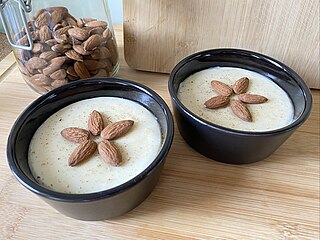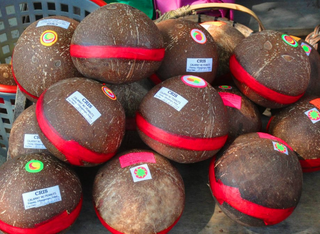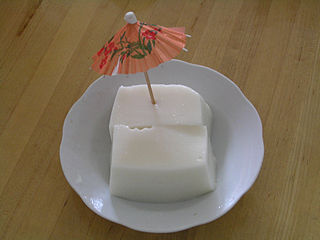
Dessert is a course that concludes a meal. The course consists of sweet foods, such as cake, biscuit, ice cream and possibly a beverage such as dessert wine and liqueur. Some cultures sweeten foods that are more commonly savory to create desserts. In some parts of the world there is no tradition of a dessert course to conclude a meal.

Blancmange is a sweet dessert popular throughout Europe commonly made with milk or cream and sugar thickened with rice flour, gelatin, corn starch, or Irish moss, and often flavoured with almonds.

Custard is a variety of culinary preparations based on sweetened milk, cheese, or cream cooked with egg or egg yolk to thicken it, and sometimes also flour, corn starch, or gelatin. Depending on the recipe, custard may vary in consistency from a thin pouring sauce to the thick pastry cream used to fill éclairs. The most common custards are used in custard desserts or dessert sauces and typically include sugar and vanilla; however, savory custards are also found, e.g., in quiche.

Rice pudding is a dish made from rice mixed with water or milk and commonly other ingredients such as sweeteners, spices, flavourings and sometimes eggs.

Filipino cuisine is composed of the cuisines of more than a hundred distinct ethnolinguistic groups found throughout the Philippine archipelago. A majority of mainstream Filipino dishes that compose Filipino cuisine are from the food traditions of various ethnolinguistic groups and tribes of the archipelago, including the Ilocano, Pangasinan, Kapampangan, Tagalog, Bicolano, Visayan, Chavacano, and Maranao ethnolinguistic groups. The dishes associated with these groups evolved over the centuries from a largely indigenous base shared with maritime Southeast Asia with varied influences from Chinese, Spanish, and American cuisines, in line with the major waves of influence that had enriched the cultures of the archipelago, and adapted using indigenous ingredients to meet local preferences.

Haupia is the Hawaiian name for a traditional coconut pudding found throughout Polynesia.

Bibingka commonly refers to a type of baked rice cake from the Philippines that is traditionally cooked in a terracotta oven lined with banana leaves and is usually eaten for breakfast or as merienda especially during the Christmas season. It is also known as bingka in the Visayas and Mindanao islands.

The manjar blanco, known in Catalan as menjar blanc or menjablanc, is a term used in Spanish- and Catalan- speaking areas of the world in reference to a variety of milk-based delicacies. It refers to variations of blancmange, a European delicacy found in various parts of the continent as well as the United Kingdom.

Kalamay is a sticky sweet delicacy that is popular in many regions of the Philippines. It is made of coconut milk, brown sugar, and ground glutinous rice. It can also be flavored with margarine, peanut butter, or vanilla. Kalamay can be eaten alone; but is usually used as a sweetener for a number of Filipino desserts and beverages. It is related to the Chamorro dessert called Kalamai.

Tembleque is a coconut dessert pudding from Puerto Rico similar to blancmange and related to Latin American manjar blancos and Filipino maja blanca. It is one of the most popular desserts in Puerto Rican cuisine.

Latík refers to two different coconut-based ingredients in Filipino cuisine. In the Visayan region it refers to a syrupy caramelized coconut cream used as a dessert sauce. In the northern Philippines, it refers to solid byproducts of coconut oil production, used as garnishing for a variety of desserts.

Maja blanca is a Filipino dessert with a gelatin-like consistency made primarily from coconut milk. Also known as coconut pudding, it is usually served during fiestas and during the holidays, especially Christmas.

Muhallebi is a milk pudding commonly made with rice, sugar, milk and either rice flour, starch or semolina, popular as a dessert in the Turkey and Middle East. While the dessert is called Muhallebi in Turkey and Iraq, the Egyptian variant is called mahalabia, the levantine variant is called mahalabiyeh.

Ube halaya or halayang ube is a Philippine dessert made from boiled and mashed purple yam. Ube halaya is the main base in ube/purple yam flavored-pastries and ube ice cream. It can also be incorporated in other desserts such as halo-halo. It is also commonly anglicized as ube jam, or called by its original native name, nilupak na ube.

Coconut bar is a refrigerated dim sum dessert found in Hong Kong, Taiwan, Southern China and in overseas Chinatowns. It is sweet and has a soft, gelatin-like texture but is white in color rather than translucent like gelatin. It is sometimes referred to as coconut pudding.

Tibok-tibok or carabao-milk pudding is a Pampangan dessert pudding made primarily from carabao milk and ground soaked glutinous rice (galapong). Originating in the Philippine province of Pampanga, it is especially popular in Cagayan. It has a soft jelly-like texture and is topped with latik before serving. It is characteristically creamy white in color and has a delicate, sweet and slightly salty flavor. It is very similar to the more common maja blanca, albeit the latter is made with coconut milk and cornstarch.

Chalakiles is a Chamorro soup from Guam made with chicken, garlic, onion, toasted ground rice, and sometimes coconut milk. Chalakiles can be the entrée or can be served before the main dish. It is considered a comfort food. It is often found at various Chamorro festivities.

















